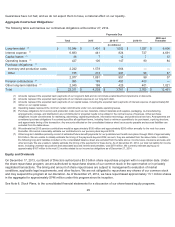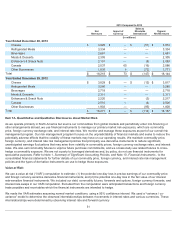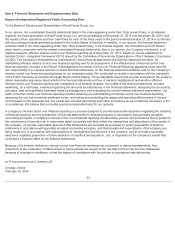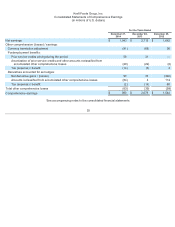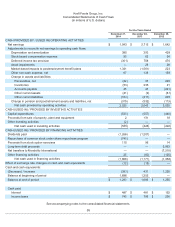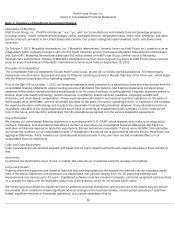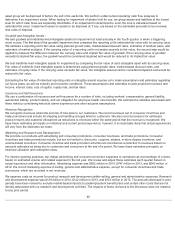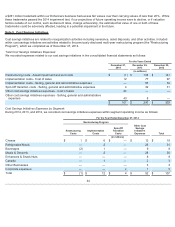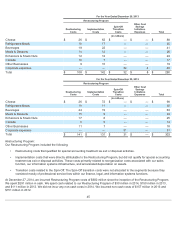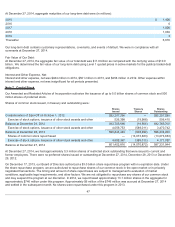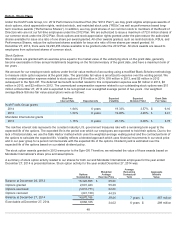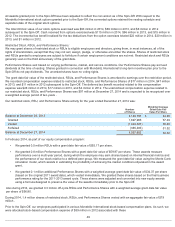Kraft 2014 Annual Report Download - page 44
Download and view the complete annual report
Please find page 44 of the 2014 Kraft annual report below. You can navigate through the pages in the report by either clicking on the pages listed below, or by using the keyword search tool below to find specific information within the annual report.
Kraft Foods Group, Inc.
Notes to Consolidated Financial Statements
Note 1. Summary of Significant Accounting Policies
Description of Business:
Kraft Foods Group, Inc. (“Kraft Foods Group,” “we,” “us,” and “our”) manufactures and markets food and beverage products,
including cheese, meats, refreshment beverages, coffee, packaged dinners, refrigerated meals, snack nuts, dressings, and other
grocery products, primarily in the United States and Canada. Our product categories span breakfast, lunch, and dinner meal
occasions.
On October 1, 2012, MondelƝz International, Inc. (“MondelƝz International,” formerly known as Kraft Foods Inc.) created us as an
independent public company through a spin-off of its North American grocery business to MondelƝz International’s shareholders
(the “Spin-Off”). MondelƝz International distributed 592 million shares of Kraft Foods Group common stock to MondelƝz
International’s shareholders. Holders of MondelƝz International common stock received one share of Kraft Foods Group common
stock for every three shares of MondelƝz International common stock held on September 19, 2012.
Principles of Consolidation:
The consolidated financial statements include Kraft Foods Group, as well as our wholly-owned subsidiaries. All intercompany
transactions are eliminated. Our period end date for financial reporting purposes is the last Saturday of the fiscal year, which aligns
with the financial close dates of our operating segments.
Prior to the Spin-Off on October 1, 2012, our financial statements were prepared on a stand-alone basis and were derived from the
consolidated financial statements and accounting records of MondelƝz International. Our financial statements included certain
expenses of MondelƝz International that were allocated to us for certain functions, including general corporate expenses related to
finance, legal, information technology, human resources, compliance, shared services, insurance, employee benefits and
incentives, and stock-based compensation. These expenses were allocated in our historical results of operations on the basis of
direct usage when identifiable, with the remainder allocated on the basis of revenue, operating income, or headcount. We consider
the expense allocation methodology and results to be reasonable for all periods presented. However, these allocations were not
necessarily indicative of the actual expenses we would have incurred as an independent public company or of the costs we will
incur in the future, and may differ substantially from the allocations we agreed to in the various separation agreements.
Use of Estimates:
We prepare our consolidated financial statements in accordance with U.S. GAAP, which requires us to make accounting policy
elections, estimates, and assumptions that affect a number of amounts in our consolidated financial statements. We base our
estimates on historical experience and other assumptions that we believe are reasonable. If actual amounts differ from estimates,
we include the revisions in our consolidated results of operations in the period the actual amounts become known. Historically, the
aggregate differences, if any, between our estimates and actual amounts in any year have not had a material effect on our
consolidated financial statements.
Cash and Cash Equivalents:
Cash equivalents include demand deposits with banks and all highly liquid investments with original maturities of three months or
less.
Inventories:
Inventories are stated at the lower of cost or market. We value all our inventories using the average cost method.
Long-Lived Assets:
Property, plant and equipment are stated at historical cost and depreciated by the straight-line method over the estimated useful
lives of the assets. Machinery and equipment are depreciated over periods ranging from 3 to 20 years and buildings and
improvements over periods up to 40 years . Capitalized software costs are included in property, plant and equipment and amortized
on a straight-line basis over the estimated useful lives of the software, which do not exceed seven years .
We review long-lived assets for impairment when conditions exist that indicate the carrying amount of the assets may not be fully
recoverable. Such conditions include significant adverse changes in the business climate, current-period operating or cash flow
losses, significant declines in forecasted operations, or a current expectation that an
39


